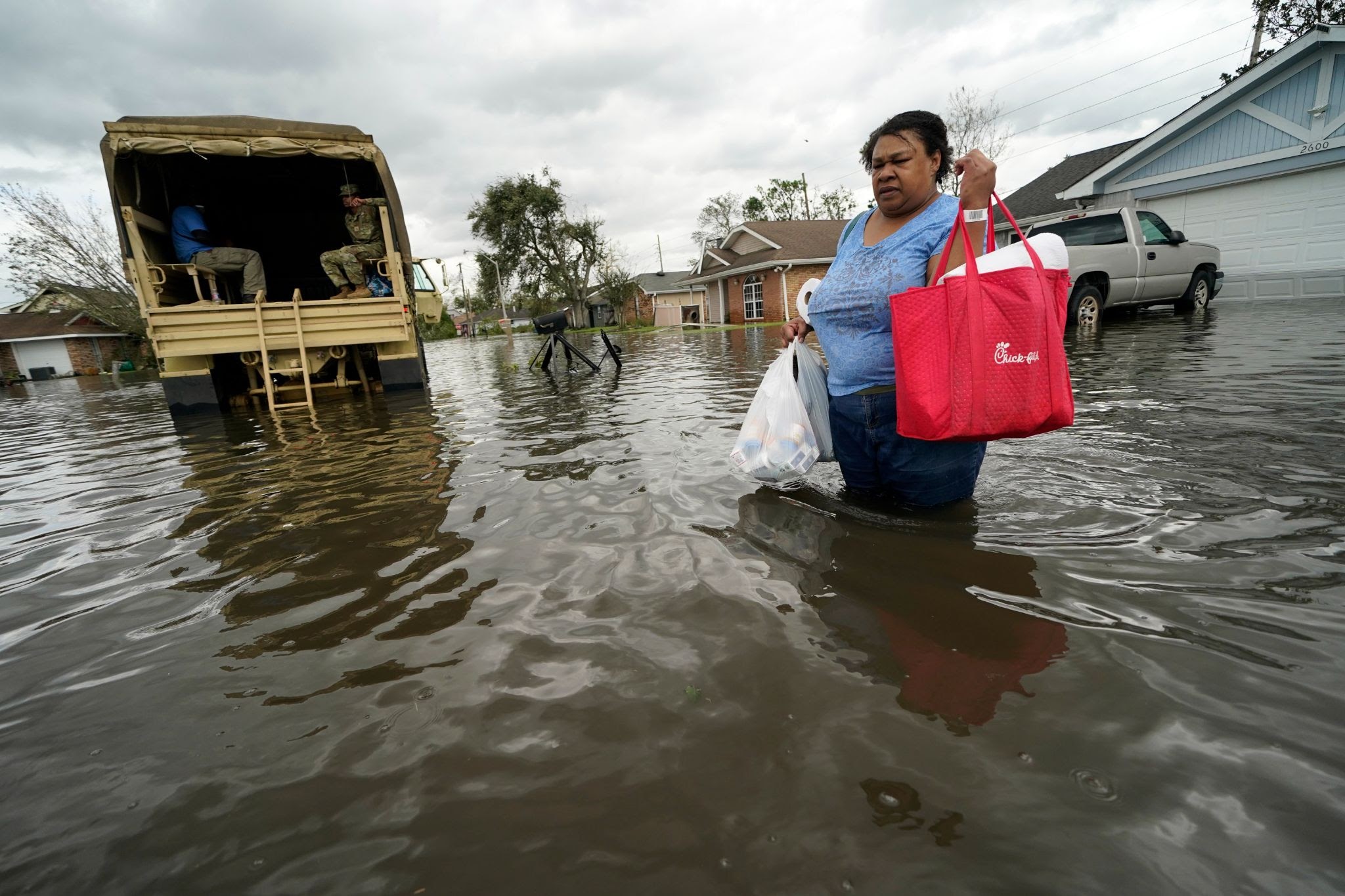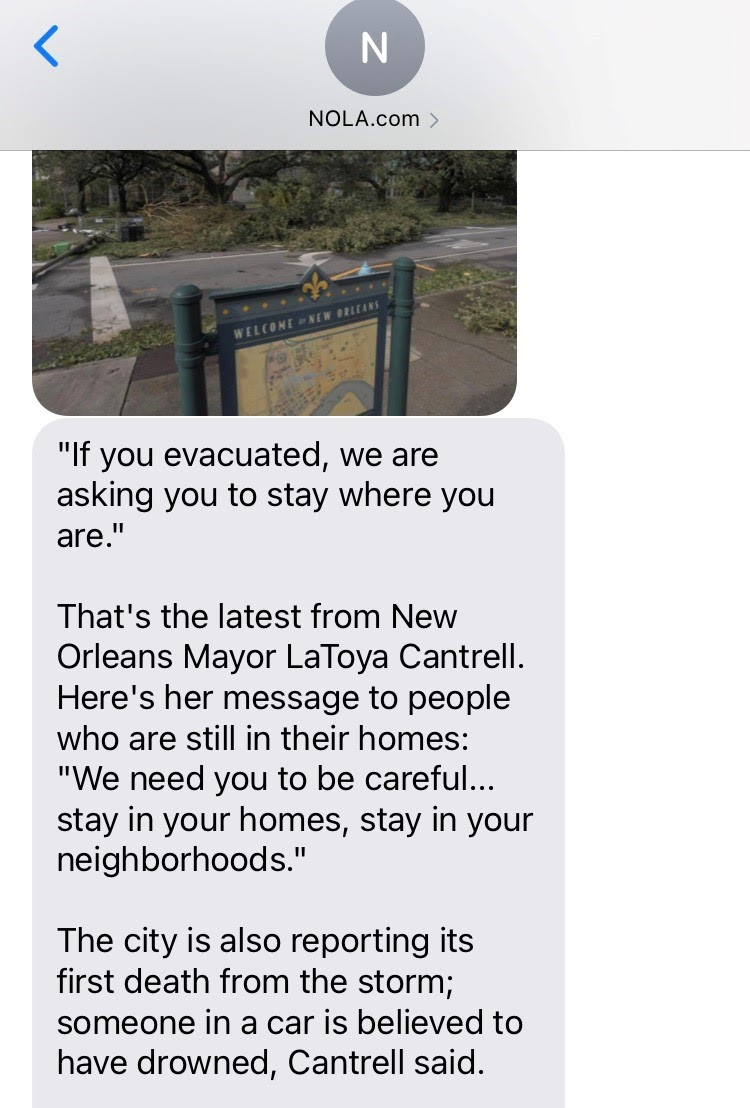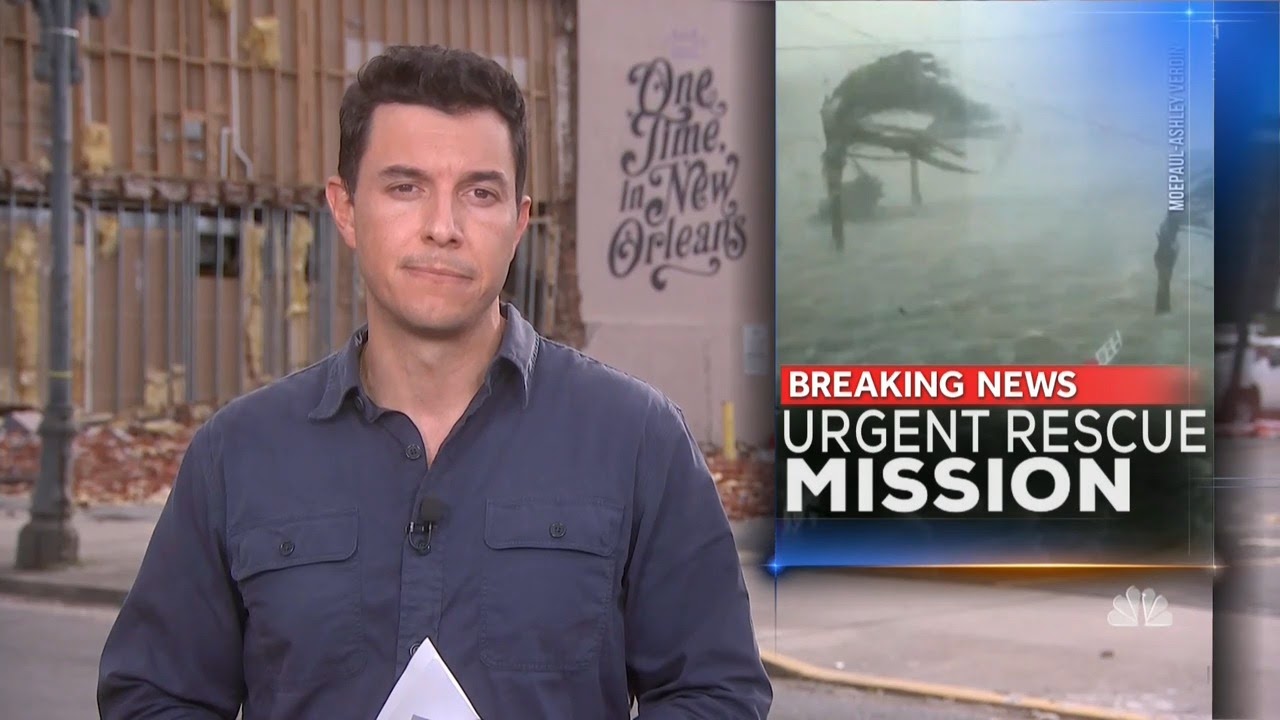On Sunday, NBC News’ Tom Llamas was in the middle of a storm.
Literally.
Standing knee-deep in water in New Orleans, Llamas was covering Hurricane Ida as it ripped through Louisiana. On Monday morning, he was filing reports for the “Today” show. By Monday evening, with Lester Holt off, Llamas was anchoring the “NBC Nightly News” from New Orleans for the second night in a row.
It has been an eventful 48 hours for Llamas, and the story is far from over. It started Sunday morning right on the shore of Lake Pontchartrain as the strong winds, steady hard rain and the start of the storm surge began.
“We were right there,” Llamas told me in an email late Monday night. “I believe in being on the ground, so when you are reporting, you’re telling the viewer something you saw with your own eyes. By being there you can meet and talk to people affected by the storm.”
Llamas and his colleagues spoke to a family that had second thoughts about not evacuating. They talked to another resident in the Lower 9th Ward who showed them the spray paint mark on the front of his house from where it flooded during Hurricane Katrina 16 years earlier to the day. He wasn’t leaving.
“He was putting his faith in God and the $15 billion spent to reinforce the levee system,” Llamas said.
After that, Llamas hustled back to the French Quarter to start working on the “Nightly News.”
“As the winds started to pick up, you could hear the howl of the hurricane up and down Canal Street,” Llamas said. “We sandwiched ourselves between a pillar and the Canal Street Mall, which gave us cover, and some protection to anchor the broadcast as Hurricane Ida slammed into New Orleans.”
It was a long night.
“The entire team spent hours soaked, fighting winds, rain, and fatigue,” Llamas said. “But the NBC News team in New Orleans were some of the company’s strongest and most experienced camera operators, audio engineers, producers and technicians. Without them, the show never makes it to air.”
After Sunday’s broadcast of the “Nightly News,” Llamas started working on a report for Monday’s “Today” show, but there was a problem. The power was out. Llamas went to bed at 1 a.m., but was back up at 4 a.m. to start another long day of coverage.
“When the storm has passed, there is really only one immediate story to tell and that is ‘Who needs help?’” Llamas said. “If you find the destruction, you’ll find people in need. When people have nowhere left to turn, that’s when reporters need to be there. Shining a light where no one else can. Who needs to be rescued? Who needs supplies? Who needs shelter? Which communities have been cut off? These are all problems we try to highlight.”
I asked Llamas one more question, one that often comes up when viewers see journalists in the middle of a scary situation: What are the emotions covering such a story? Are you scared while it’s happening? Is it heartbreaking when you see the devastation left behind? Or do you compartmentalize all that in order to do the job?
“There is always emotion,” Llamas said. “What separates reporters is how they use that emotion. My friends and family live in New Orleans. It’s something I let the viewers know. Why not? I know this community, I care about this community, and that’s why I’m not going to take my job here for granted. You certainly worry about your team and accidents that can happen covering a storm.”
“There is no doubt heartbreak,” Llamas continued. “I’d find it odd walking away from a disaster and not having some type of guilt that you get to leave this situation when so many are in distress. We are there to do a job and we do it with respect and standards. But there is always a human connection.”
Llamas pointed to when he covered the recent Surfside condo collapse in South Florida.
“I knew families who lost their mothers and grandmothers,” Llamas said. “I left Miami and was out of it for a few days back in New York. I kept thinking about all those people who were crushed. And now in New Orleans I interviewed a mother who had lost everything and had no idea where she was going to stay or eat. She was pregnant and had six other kids. She waded through floodwaters that reached her stomach. Imagine that. I can’t forget that. I’m not going to forget that. We told America about her and the problems she was facing, and then I asked her what she would say to government leaders. Her answer was simple: ‘Help.’ I hope our report in some way, any way, will help.”
How Louisiana’s Advocate is covering and living through a grim natural disaster

Jerilyn Collins returns to her destroyed home with the assistance of a Louisiana National Guard high-water vehicle to retrieve medicine and a few possessions, after she evacuated from rising floodwater in the aftermath of Hurricane Ida in LaPlace, La. on Monday. (AP Photo/Gerald Herbert)
Imagine being a major news organization and covering one of the biggest stories you’ll ever come across. Now imagine doing it with no power, spotty cell phone service and staff that, in some cases, have been forced to evacuate to other states.
Now you have some idea of the kinds of challenges facing the journalists in Louisiana after Hurricane Ida slammed the state exactly 16 years after Hurricane Katrina. I traded emails Monday with Peter Kovacs, editor of The Advocate and The Times-Picayune in Louisiana.
“Our first appreciation is that this is Katrina redux,” Kovacs told me. “The federal levees held but most everything else failed. There is no power in New Orleans or Jefferson Parish and almost none in Baton Rouge.”
The paper was printed and delivered Sunday morning ahead of the powerful Category 4 storm, and even printed Monday morning, although conditions made it impossible to deliver until roads were passable later in the day. But the power outages are now causing issues with printing.
“There is no power for our presses so we are printing Tuesday with the support of our partners in Jackson and Mobile,” Kovacs said.
Kovacs said online traffic was about three times greater than normal leading up to the storm and about five times greater as the storm was hitting Sunday. On Monday, the outlet was getting out information any way it could, posting updates as often as every five minutes. Kyle Whitfield, the digital audience director at The Advocate, sent me an example of technology that delivers news by text message. It already has more than 10,000 signups.
“These are crucial with the power grid taken down in our region,” Whitfield told me. “Text message is the only reliable way to communicate to readers.”
Here’s what it looks like:

(Courtesy: The Advocate)
“Texting seems to work,” Kovacs said. “Reminds me that I had never heard of texting until Katrina in 2005.”
Meanwhile, journalists are doing what journalists do: their jobs despite the conditions. They are working at various locations around New Orleans and the state and are using generator power at the newsrooms in Baton Rouge and Lafayette. Some journalists are working from Alabama and Texas — places they were forced to evacuate to. That actually has been helpful because power and the internet there are more reliable.
“People are in good spirits and working hard and we have had great support from the Georges family (the owners) and our publisher, Judi Terzotis,” Kovacs said.
Unacceptable behavior
Speaking of hurricane coverage, in Monday’s newsletter, my colleague Al Tompkins (a veteran broadcast journalist) told me, “God bless the journalists who are away from their families, who are walking around for days in wet socks while snarky bystanders shout ‘fake news’ at them.”
Would people really do that during hurricane coverage?
Sadly, yes. Well, we saw such an example on Monday. While doing a live report from Mississippi, NBC News correspondent Shaquille Brewster was confronted by a rather angry and aggressive man who jumped out of a white pickup truck. Brewster kept his poise and turned away so the man would not be in the shot. Amazingly, Brewster kept delivering his report, but eventually had to send it back to the studio because of the disruption. At that point, the man jumped into Brewster’s face and it sounded like he yelled, “Report it accurately!”
Back in the studio, host Craig Melvin said, “We’re going to check in with Shaq Brewster just to make sure all is well. There is a lot of crazy out there. There is a lot of crazy!”
After an interview with Louisiana Congressman Troy Carter, Melvin said Brewster and the crew were safe. Melvin tweeted, “This is beyond unacceptable and disgusting. @shaqbrewster was trying to do his job on a beach in Gulfport, MS. Shaq is ok. This guy who nearly attacked him clearly is not.”
Brewster tweeted, “Appreciate the concern guys. The team and I are all good!”
How awful. Brewster, who has been doing superb work with probably no sleep for more than a day, was accosted for doing his job. And it was about a hurricane, for crying out loud.
In a statement, MSNBC president Rashida Jones said, “Shaq Brewster is an exceptional journalist. Like the consummate professional, he did not let someone intimidate him from doing his job. We’re glad he and the team are safe, and we couldn’t be more proud and supportive of their work.”
Some more hurricane coverage you should check out
- Photos and video from The Advocate.
- Video from The New York Times, Maya Blackstone and Taylor Turner with “Ida Leaves a Path of Destruction Through Louisiana.”
- For The Atlantic, Robinson Meyer with “We’re Hitting the Limits of Hurricane Preparedness.”
- The Associated Press’ Rebecca Santana, Jay Reeves and Kevin McGill with “Hurricane Ida traps Louisianans, shatters the power grid.”
The other major story
Here’s the rare use of a “flash” sent out Monday afternoon by The Associated Press:
WASHINGTON (AP) — America’s longest war ends after 20 years as last US troops depart Afghanistan, concluding final, frantic airlift.
A “flash” is saved for only the biggest news stories. AP’s internal guidelines say, “In the case of exceptionally important news, AP may send a ‘Flash.’” (Here’s a 2019 AP story about the use of a “flash.”)
Certainly, the end of the longest war in U.S. history qualifies. The Pentagon made the announcement of the completion of Afghanistan withdrawal a little before 5 p.m. Eastern time.
Some notable pieces worth your time:
- In The Atlantic, David Rothkopf with “Biden Deserves Credit, Not Blame, For Afghanistan.”
- Two pieces from The Washington Post’s Jennifer Rubin: “Biden tells some hard truths few want to hear” and “The State Department deserves more credit for its effort to evacuate Americans from Afghanistan.”
- For NBC News, Rebecca Shabad and Shannon Pettypiece with “Last plane carrying Americans from Afghanistan departs as longest U.S. war concludes.”
- Politico’s Anita Kumar with “As Biden ends mission in Afghanistan, a refugee backlash looms at home.”
- In Vanity Fair, Adam Ciralsky with “How Turf Wars Mucked Up America’s Exit from Afghanistan.”
- The New York Times’ Thomas Gibbons-Neff with analysis in “In Afghanistan, an Unceremonious End, and a Shrouded Beginning.”
‘The View’ returns to the studio

The cast of ABC’s The View — from left to right: Whoopi Goldberg, Sara Haines, Joy Behar and Sunny Hostin — as it prepares for season 25. (Courtesy: ABC/Robert Ascroft)
ABC’s “The View” returns to its New York City studios next Tuesday to start its — get this! — 25th season. Hard to believe it has been that long, right? Moderator Whoopi Goldberg and co-hosts Joy Behar, Sunny Hostin and Sara Haines will all return to the studio for the first time since March 2020. The show had been taped virtually because of the pandemic. Also look for Ana Navarro to continue her role as occasional guest host.
The big change is that Meghan McCain, the most outspoken conservative co-host, has left the show. The show isn’t replacing her with one conservative voice, but many. Over the season, guest co-hosts will include Utah congresswoman Mia Love, Condoleezza Rice, S.E. Cupp, Carly Fiorina, Eboni K. Williams, Mary Katharine Ham, Alyssa Farah, Cameran Eubanks and Gretchen Carlson.
In addition, “The View” will have “Flashback Fridays” and talk to many of the show’s former co-hosts. The first will be Star Jones on Sept. 10.
If you’re a fan of the show, check out a new podcast debuting on Sept. 14 called “Behind the Table.” New episodes will be posted weekly.
What the heck happened?
Over the weekend, ESPN showed a bunch of high school football games featuring some of the best teams in the country. In one game, IMG Academy from Florida played a school called Bishop Sycamore. IMG won 58-0 and even the announcers questioned if Bishop Sycamore should have been in this game and if it was unsafe for their players.
And the more reporting that’s done, the shadier the story gets.
So what in the world happened and who is to blame?
The best breakdown I’ve seen is from Awful Announcing’s Ben Koo. It’s a complicated story, so read Koo’s story for all the details. And while it feels as if ESPN was scammed, it does bear some responsibility for this fiasco.
On ESPN’s “Around The Horn,” Emily Kaplan said, “We got here because adults lied and adults didn’t do their due diligence and kids were embarrassed and their safety was put in danger.”
Tim Cowlishaw added, “I think there’s a lot of people who need to look at what happened over the weekend, including ESPN. You can’t have a game like that.”
Media tidbits
- Variety’s Brian Steinberg writes about the controversy that the new ABC News boss has to deal with in “Kim Godwin Walks Tricky Terrain in Early Tenure at ABC News.”
- Speaking of the ABC News controversy, The Daily Beast’s Lachlan Cartwright says it’s causing serious tension in his piece: “Bombshell Lawsuit Has ‘GMA’ Co-Hosts at Each Other’s Throats, Sources Say.”
- This media story has a lot of folks riled up on social media. It’s The Washington Post’s Manuel Roig-Franzia with “Former NRA spokeswoman Dana Loesch, a rising right-wing radio star, doesn’t care if you call her a murderer.”
- The Tampa Bay Times editorial board writes about the press secretary for Florida Gov. Ron DeSantis: “Press secretary Christina Pushaw’s unneeded meltdown over a routine news story.”
- As previously reported, NFL greats Peyton and Eli Manning will star as commentators in special “Monday Night Football” broadcasts for ESPN. The MegaCasts would be separate from the normal “MNF” broadcasts and produced in conjecture with Peyton Manning’s Omaha Productions. It was originally thought that there would be a host to help moderate the conversation between the Mannings and ESPN NFL reporter Adam Schefter’s name was floated. But now Front Office Sports’ Michael McCarthy reports that there won’t be a permanent host and the Mannings are likely to do the broadcast by themselves.
- Legendary sports journalist Jackie MacMullan ends her career with ESPN today by appearing on “Around the Horn” at 5 p.m. Eastern. The episode actually will appear on ESPN2.
Hot type
- The New York Times’ Michael Wilson, Ashley Southall and Chelsia Rose Marcius write about child welfare in “At Birth, She Already Had a Case File. At 7 Years Old, She Was Dead.”
- A few days old, but well worth the read. In an op-ed for The Los Angeles Times, Karen Gallardo, a respiratory therapist at Community Memorial Hospital in Ventura, California, writes, “Here’s what the seven stages of severe Covid-19 look like.”
- For Vox, Constance Grady with “20 years after Aaliyah’s death, her story only feels more tragic.”
Have feedback or a tip? Email Poynter senior media writer Tom Jones at tjones@poynter.org.
More resources for journalists
- Subscribe to Poynter’s new Friday newsletter, Open Tabs with Poynter managing editor Ren LaForme, and get behind-the-scenes stories only available to subscribers.
- Will Work for Impact: The Fundamentals of Investigative Journalism — Enroll by Sept. 1
- Covering Jails and Police Reform (Webinar series) — Sept. 22-Oct. 20, 2021
- Diversity Across the Curriculum (Seminar) — Apply by Sept. 26
The Poynter Report is our daily media newsletter. To have it delivered to your inbox Monday-Friday, sign up here.







